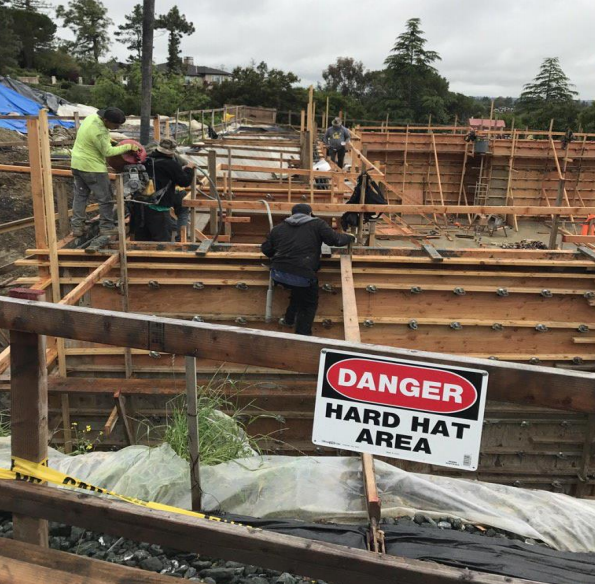Spot The Safety Violation: A Lot of Good This Sign Is Doing
Did these workers not see the pretty prominent sign or are they just not worried about their heads’

It’s critical that you train workers on all of the equipment they’ll need to use on the job, including PPE. It’s also a good idea’and may even be required under OHS law’to post signs reminding workers to wear certain PPE in designated areas. But even the clearest, most obvious signs won’t guarantee that workers will actually wear their PPE when needed.
This picture shows a worksite with a very clear sign that says, ‘Danger Hard Hat Area.’ But despite this prominently posted sign, at least the three workers in the foreground of the photo are not wearing the required hardhats. Instead, they have on baseball hats, which provide little to no protection to their heads.
Wearing hardhats properly can literally mean the difference between life and death.
Worker with hardhat lives: A 70 lb. metal beam fell from the 7th storey of a condo development and struck a worker on the head, face and torso. He was taken to the hospital in serious condition but survived. Police credited the worker’s hardhat with saving his life.
Worker without hardhat dies: A worker making a delivery to a construction project parked his truck and stepped from the vehicle when he was hit by a one-pound tape measure, which had slipped off the belt of a worker at the top of the tower under construction. The man, who wasn’t wearing a hardhat at the time, was struck in the head and later died.
5 STEPS TO PROTECTING WORKERS’ HEADS
The use of hardhats is generally covered in the requirements in the OHS regulations for protecting workers’ heads. To ensure you comply with these requirements, take these basic steps:
Step #1: Determine if Safety Headwear Is Required
The use of safety headwear is generally required when workers are exposed to the risk of injury to their heads by falling, flying or thrown objects, or other harmful contacts (such as with hazardous substances or electricity). And some workplaces’most notably construction sites’are presumed to pose a safety hazard to workers’ heads and so safety headwear is usually required by all workers in such workplaces.
Step #2: Determine Appropriate Type of Safety Headwear
Next, determine the appropriate type of safety headwear, which in most cases will be some type of hardhat. This determination may be based on the nature of the head hazards. For example, if a worker may be exposed to electrical hazards, the safety headwear should have an appropriate non-conductive rating. And most jurisdictions require safety headwear to comply with a standard such as CSA Z94.1’05, Industrial Protective Headwear.
In addition, hardhats may need to be red, orange or another very visible color or have reflective decals if worker visibility is a safety issue. You may also need to ensure that workers have liners for their hardhats if they’ll be working in or exposed to cold conditions. And safety headwear may require some kind of retention system such as a chin strap if workers are working at heights, in windy conditions or in other circumstances in which their hardhats could get dislodged. Failing to comply with these requirements can result in injuries to workers and fines.
Example: A worker, who wasn’t wearing protective headwear, was struck in the head by a board that had slipped off a roof. As a result, a construction company pleaded guilty to failing, where a worker is required to use industrial protective headwear, to provide a suitable liner where it’s necessary to protect the worker from cold conditions, and a retention system to secure the industrial protective headwear firmly on the worker’s head where the worker is likely to work in conditions that may cause the headwear to dislodge, resulting in serious injury to a worker. The court fined the company $10,000 [Danbo Construction, Saskatchewan Govt. News Release, April 25, 2017].
Step #3: Provide or Require Workers to Provide Appropriate Headwear
Once you’ve figured out the appropriate type of safety headwear, either provide such head protection for workers or ensure that they provide their own headwear. Regardless of who pays for or provides the safety headwear, it must comply with the OHS requirements.
Step #4: Set Rules for Use & Care of Safety Headwear
Set appropriate safety rules for the use and care of safety headwear’and periodically review these rules with workers. These dos and don’ts for headwear are some examples of basic rules to include:
- Do inspect headwear before each use. (Use this checklist.)
- Do replace headwear that has been struck’even if no damage is visible.
- Do clean the suspension and shell regularly according to the manufacturer’s instructions.
- Do remove and destroy any headwear if its protective abilities are in doubt.
- Don’t transport headwear in rear windows of vehicles.
- Don’t paint the plastic shell. Paint solvents can make the plastic brittle and more susceptible to cracks.
- Don’t use winter liners that contain metal or electrically conductive material underneath Class G or E headwear.
- Don’t put anything between the suspension and the shell.
Step #5: Train Workers on Safety Headwear Rules
As always, train workers on your rules for safety headwear and ensure that they understand and comply with these rules on the job. For example, give them this handout as an accompaniment to a toolbox talk on head safety.